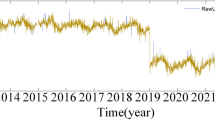Abstract
The use of global statistics to assess spatial dependence and deviations from spatial randomness often is carried out on a single dataset. However, there are situations where new datasets become available periodically, and it is of interest to determine whether there has been a temporal change point, where a new regime of global spatial autocorrelation has been established. If the global test is simply repeated every time period, change will be often be found by chance alone, even when it has not occurred, due to the multiple hypothesis testing. Cumulative sum methods are introduced as a method for monitoring the global statistics; they address the problem of multiple testing, and are optimal for finding temporal changes in the global spatial statistics. The method is illustrated through an application to data on breast cancer mortality in the northeastern United States.

Similar content being viewed by others
References
Anselin L (1995) Local indicators of spatial association—LISA. Geogr Anal 27:93–115
Getis A, Ord JK (1992) The analysis of spatial association by use of distance statistics. Geogr Anal 24:189–206
Griffith DA (1987) Spatial autocorrelation: a primer. Association of American Geographers, Washington, DC
Han D, Rogerson P (2003) Application of a GIS-based statistical method to assess spatio-temporal changes in breast cancer clustering in the northeastern United States. In: Khan O, Skinner R (eds) Geographic information systems and health applications, pp 114–138
Hawkins DM, Olwell DH (1998) Cumulative sum charts and charting for quality improvement. Springer, New York
Lawson AB, Kleinman K (2005) Spatial and syndromic surveillance for public health. Wiley, New York
Montgomery D (1996) Introduction to statistical quality control. Wiley, New York
Moran PAP (1950) Notes on continuous stochastic phenomena. Biometrika 37:17–23
Rogerson P (1997) Surveillance methods for monitoring the development of spatial patterns. Stat Med 16:2081–2093
Rogerson P (2001) Monitoring point patterns for the development of space–time clusters. J R Stat Soc Ser A 164:87–96
Rogerson P (2006) Formulas for the design of CUSUM quality control charts. Comm Stat 35:373–383
Rogerson P, Sun Y (2001) Spatial monitoring of geographic patterns: an application to crime analysis. Comput Environ Urban Syst 25(6):539–556
Siegmund D (1985) Sequential analysis: tests and confidence intervals. Springer, New York
Tango T (1995) A class of tests for detecting “general” and “focused” clustering of rare diseases. Stat Med 7:649–660
Author information
Authors and Affiliations
Corresponding author
Rights and permissions
About this article
Cite this article
Lee, G., Rogerson, P. Monitoring global spatial statistics. Stoch Environ Res Risk Assess 21, 545–553 (2007). https://doi.org/10.1007/s00477-007-0138-x
Published:
Issue Date:
DOI: https://doi.org/10.1007/s00477-007-0138-x




